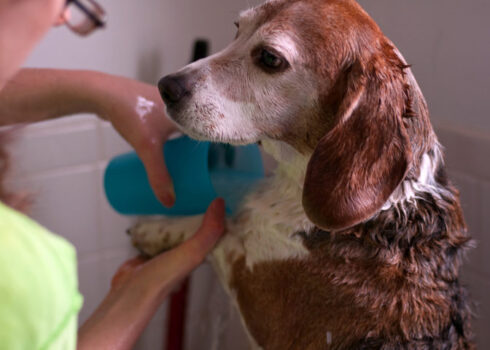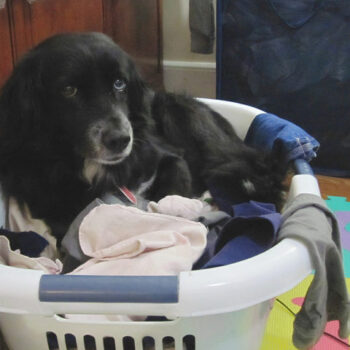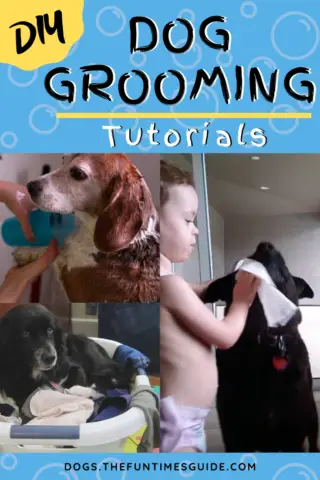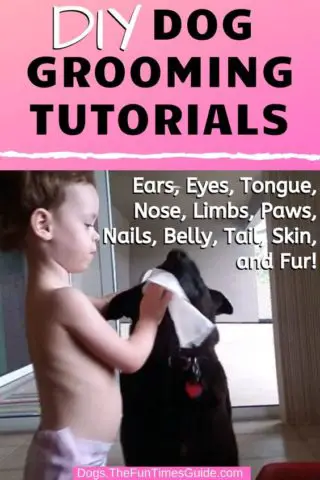DIY dog grooming is important because your dog’s health is — directly and indirectly — influenced by how much time you devote to the process of caring for and cleaning your dog.
Yes, some dog breeds require more attention to grooming than others — but all dogs require some very basic grooming in order to maintain healthy teeth, ears, coat, skin, nails, and eyes.
So, just because you don’t have a long-haired dog or a dog with an overbite, don’t think that you don’t have to care for your dog’s fur or brush your dog’s teeth.
Even though your dog’s nails will naturally wear down a bit if he plays outside, a lot or goes on a lot of walks, this doesn’t mean that you don’t have to trim your dog’s nails regularly.
Likewise, a dog’s ears and eyes must remain free of debris, allergens, and mites in order to avoid issues with hearing and eyesight.
You can choose professional dog grooming, or you can do it yourself. Here’s how much professional dog grooming costs.
DIY Dog Grooming Tips & Tutorials
Things like matted fur and decaying teeth & gums can lead to other dog health problems. Regular grooming goes a long way toward prolonging your dog’s life!
These are our best DIY dog grooming tips — if you don’t want to have your dog professionally groomed and prefer to do it yourself:
- How to clean your dog’s ears – if your dog is shaking his head a lot, clean his ears.
- What’s a remedy for dry dog skin? – see the one thing that worked for us after our vet recommended it.
- How to trim your dog’s nails – tips to make trimming your dog’s nails much easier.
- Dog flea & tick preventatives – Frontline Plus is good, but see which ingredients work best.
- Natural remedies for fleas & ticks – if you prefer going the all-natural route, these are the best options.
- How to give your dog a bath – tips & tools to make bathing your dog even easier.
- Should you trim a dog’s hairy toes? – some dogs grow extra fur between their toes.
- How to brush your dog’s teeth – tips to make brushing your dog’s teeth easier.
- Is there a toy that will brush dog teeth? – the Bristly dog toy has cracks & crevices that work!
- How to care for your dog’s eyes – small dogs with lots of fur around the eyes need extra attention.
- The best dog brush – see how the Furminator is different from most dog brushes.
Oh, and dog bad breath can be remedied by putting an additive in your dog’s drinking water. BONUS: Here are 10 recipes for homemade dog breath treats!
Dog Odors, Pet Stains, And Fur Issues
Grooming your dog will take care of the odors, fur, and dirt on your dog.
You also need to take care of the odors, fur, and dirt that result around your dog. Your home will look and smell better. Your entire family (and your guests) will appreciate it!
Here are our best tips for dealing with dog odors and pet stains:
- Dog odors 101 – a collection of tips for dealing with dog smell.
- How to clean muddy paws quickly – ways to get your dog to cooperate while having their paws cleaned.
- Shedding and dog fur removal – tips for removing dog fur from your furniture, your clothes & everything else.
- Pledge fabric sweeper for pet hair – see how it works + DIY instructions for making it reusable.
- How to remove dog urine stains and odors – tips for removing dog pee stains and the odor that lingers.
- Dog friendly microfiber towels – these are the best towels for dog baths, wiping muddy paws, and more!
- Teach your dog to “shake” wet fur – before coming in the house on a rainy day or leaving the tub/shower area after a bath.
- How to remove a tick from your dog – the tried and true absolute best method to remove ticks (…and we definitely have a lot of them around here!)
Things You Need To Know About Your Dog’s Body Parts
Following are some of the most important things you need to know about your dog’s fur & shedding, ears & hearing, eyes & eyesight, nails & paws, teeth & mouth
- Do loud noises hurt a dog’s ears? – yes, there are 2 primary ways to protect your dog’s hearing and make your dog less scared.
- Should you remove dog dew claws? – a dew claw is like a thumb; here’s everything you need to know about your dog’s extra appendage.
- How do you care for a dog’s dry tongue? – if your dog’s tongue sticks out all the time, it’s called Hanging Tongue Syndrome; see how to care for your dog’s tongue.
- What do black spots on a dog’s tongue mean? – many people think only Chow dogs have spots on their tongue… but that’s not true!
- What color dog toys are best? – based on what we know about dog eyesight, there are only 2 colors of dog toys worth buying!
- How can you tell if your dog has Lyme Disease from a tick bite? – personally, I have Lyme Disease and my dog has another tick-borne disease: Rocky Mountain Spotted Fever.
- Can dogs watch TV? – see all the ways that we can compare a dog’s eyesight to a human’s eyesight.
Why DIY Dog Grooming Is Important
The goal of every new dog owner should be to get your dog used to being touched in ways that will facilitate routine grooming and veterinary care — beginning in puppyhood and continuing all throughout their life. (These are called “dog husbandry behaviors”.)
Trust me, getting your dog comfortable with all the poking, prodding, and touching will definitely make grooming and vet visits much less stressful — for both you and your dog!
For example, if your dog can get used to these 3 things:
- You handling all parts of your dog’s body (face, mouth, ears, eyes, tongue, nose, limbs, paws, nails, belly, tail, fur, skin)
- You bending and gently manipulating your dog’s joints and extremities (paws, elbows, shoulders, hips, neck)
- You getting your dog to assume specific body positions on command (standing, sitting, laying on their side, laying belly up)
Then, all of these things will be so much easier:
- Taking medicine
- Getting ear drops (used when cleaning a dog’s ears), eye drops (for treating eye infections, dog allergies, and when cleaning a dog’s eyes and tear stains), nose drops (like the Bordetella inhaler vaccine)
- Brushing teeth
- Brushing fur
- Clipping nails
- Removing burrs, ticks, and insect stingers
- Cleaning muddy paws
- Standing still on the scale at the vet’s office
- Putting on and wearing an e-collar after surgery, a hot spot, or other ailment where your dog is likely to lick
- Being picked up — to put them in the car or on a veterinarian’s examination table
- Veterinary visits in general
More DIY dog grooming tips!
Like this post? Save it to read again later… or share with others on Pinterest!










Comments are closed.